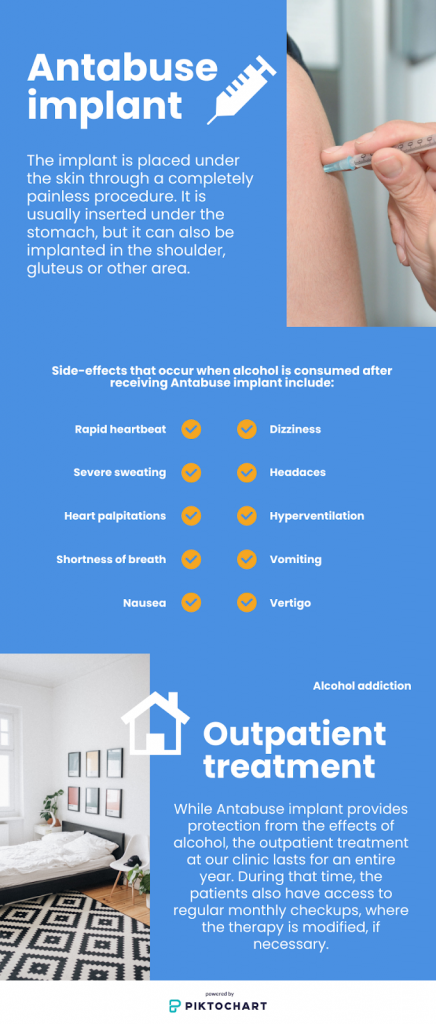
Table of contents:
Alcohol addiction is a disease that destroys the lives of millions of people around the globe. Not only does it affect the person who consumes alcohol, but it also has a negative effect on their families, and society as a whole. Fortunately, alcoholism can be cured through implementation of modern medical procedures. However, this requires cooperation from the addicts and doctors, as well as from individuals who are closest to the person struggling with addiction.
In this article we will take a look at Antabuse implants, a procedure that is a vital part of the treatment for alcohol addiction. You will be able to learn what Antabuse implants are, how they work, how safe they are, and why they are so beneficial in the treatment of alcoholism.
What are Antabuse implants and how do they work?
First discovered during the 1930s, Disulfiram is a substance that has been used for treating alcohol dependence for almost a century now. While this form of medication is nothing new, it remains, to this day, one of the most effective substances for prevention of alcoholism. Antabuse works by preventing the normal processing of ethanol in the digestive system. Instead, a buildup of acetaldehyde, a dangerous substance, occurs, which results in nausea, rapid heartbeat, and many other unpleasant symptoms which should severely discourage a patient from consuming alcohol.

Initially, Antabuse, or Disulfiram, as it is also known, was only available in pill form. This medication is one of the oldest FDA approved forms of therapy that works for treating alcoholism. While the pills were effective, the actual application of therapy proved to be quite challenging: patients would sometimes purposefully not take the pills and return to alcoholic beverages once again.
The breakthrough happened during the 1960s, when the Antabuse implants were first created. After that point, the constant release of substance into the bloodstream was guaranteed. This made returning to alcohol, without consequences, impossible.
Most importantly, implants provide a period during which the person is completely protected from the effects of alcohol. At that time, the individual has a chance to sort out any physical and mental issues that might be causing the desire to return to destructive habits. This is why Antabuse implants are considered as an additional layer of protection during the difficult period of resocialization upon completion of the treatment.
How many types of implants exist?
There are two types of implants in use today. While they work on similar principles, they are fundamentally different. Let us take a look at them in more detail:
Disulfiram implants
Upon consumption, alcohol is broken down and neutralized in the liver. However, when a person has a Disulfiram implant injected, that process is stopped. As a result, a buildup of acetaldehyde occurs when alcohol is consumed, immediately resulting in symptoms that mimic those of a hangover. Besides nausea, severe headaches, hyperventilation, and vertigo, many other symptoms may also be experienced.
The procedure of insertion is simple and leaves no scars, nor does it require stitches afterward. Because the Disulfiram implant effectively stops a person from consuming alcohol, it gives them enough time to find the inner strength again and continue with recovery.
Naltrexone implants
This form of implant was invented after Disulfiram. The pills came in 1984, and the implants first appeared in 2006. Naltrexone implants have been used for treatment of alcohol addiction ever since. The implant works by blocking the receptors in the brain.
Prior to naltrexone therapy, patients need to undergo a complete detox procedure, which removes all traces of alcohol from the system. If the detox is performed correctly, patients will experience negative symptoms, such as nausea and vomiting, immediately after receiving the implant.
After this, patients feel a reduction in urge to consume alcohol. In this way, naltrexone helps them during the process of rehab, while they are still getting used to life without alcohol.
Naturally, the naltrexone implant therapy can only be performed in medical facilities and under strict supervision of doctors who will make sure that everything runs correctly, according to the treatment protocol.
Can an implant for alcoholism cure addiction on its own?
Antabuse implants play a vital role in breaking the habit of drinking and using it as a coping mechanism to deal with everyday stress. Once the individual stops abusing alcohol altogether, it motivates them to find healthier ways to deal with their problems. However, while implants are tremendously effective in their own way, they do not remove the physical and psychological dependence of alcohol.

For that to happen, a person must undergo a complete addiction treatment program designed to prevent the urges for alcohol consumption once and for all. The healthcare experts must take into account the physical and mental state of the patient, prescribe the necessary medication to remove all signs of withdrawal symptoms, and tackle any existing psychological problems that serve as a barrier preventing them from making a complete recovery.
How safe is this form of therapy?
The procedure of inserting an implant under the skin is completely painless, and the results are noticed immediately. This entire process is very simple and it is considered as a well-tolerated procedure. After receiving the implant, the person will be protected from the effects of alcohol. This is because a precise dose of medication is automatically released from the implant into the bloodstream each day for up to one month, following the procedure.

The implant can be injected under the skin, usually in the stomach area. However, implants can also be placed in other areas as well, such as the forearm or the gluteus.
As far as safety goes, this procedure has been performed successfully for many years now, and it has proven to be very dependable.
What are the possible side effects?
Disulfiram and alcohol are a combination that do not go well together due to this substance being a powerful and specific antagonist to alcohol. While there are many side effects that can and will occur when these two substances are mixed, some people might still attempt to do it. If that happens, a strong reaction occurs inside the body, generating symptoms that mimic those of a hangover, but usually much more drastic.
People who receive Antabuse implants and try consuming alcohol might experience some of the following symptoms:
- Nausea
- Rapid and irregular heartbeat
- Sudden drop in blood pressure
- Severe headaches
- Shortness of breath
- Intense sweating
- Hyperventilation
- Vomiting
These symptoms might be more or less pronounced, depending on the amount of alcohol consumed and the individual toughness. However, in any case, the consumption of alcohol when under the influence of Antabuse implant is strictly forbidden, as it results in a plethora of complications. This is the very reason why the implants are considered so effective, as the intense negative effects cause former addicts to create a strong repulsiveness toward alcohol.
Why Antabuse implants present a good chance to return to an alcohol-free life
Following a successful treatment plan for alcoholism that encompasses a complete detoxification, psychotherapy, and application of proper medication, the next logical step is the Antabuse implant that will provide an additional layer of support to the person in the process of rehabilitation. In this way, patients receive a chance to reject alcohol once and for all and return to their everyday lives with a low risk of relapsing.
At our clinic, we offer two plans for treatment of alcohol dependence, which include the implementation of antabuse implants.
7-day procedure for treatment of alcoholism
In our treatment for alcoholism, an Antabuse implant plays an integral part in achieving aversion to alcohol. However, implants alone are not enough to achieve success in the battle against alcoholism. For that, patients have to undergo the entire treatment, which includes detoxification, physical recovery, psycho-stabilization, and other procedures.
During our 7-day treatment, patients work toward achieving physical and mental recovery, which will allow them to return to their daily lives without feeling the urge to consume alcohol ever again.
10-day procedure for treatment of alcoholism
The full 10-day treatment for alcohol dependence includes additional therapies and procedures that lead to deeper recuperation of the entire individual, improving their mental and physical state. This program gives patients more time to adjust to life without alcohol, while strengthening their dedication to pursue a healthier lifestyle.
Following a complete 10-day treatment, patients leave our clinic eager to make up for all the time lost during their struggles with alcoholism.
Contact us to learn how to join thousands of others who were able to defeat alcohol addiction >>>







